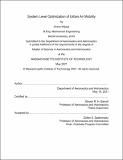| dc.contributor.advisor | Barrett, Steven R. H. | |
| dc.contributor.author | Wijaya, Grace | |
| dc.date.accessioned | 2022-01-14T15:20:00Z | |
| dc.date.available | 2022-01-14T15:20:00Z | |
| dc.date.issued | 2021-06 | |
| dc.date.submitted | 2021-07-27T14:20:44.691Z | |
| dc.identifier.uri | https://hdl.handle.net/1721.1/139561 | |
| dc.description.abstract | The rise of interest in urban mobility, along with trends in vehicle electrification and autonomy have led to the development of electric vertical and takeoff landing aircraft to offer Urban Air Mobility (UAM) services. We have quantified the market demand of UAM for 5 U.S. cities considering demand from substitution of ground based transport through UAM services for commutes and airport access. By quantifying the number of travelers in each city who would be willing to pay for the UAM service, we find that the unconstrained market potential demand for a city reaches up to 585,000 daily round trips, but varies for different cities and price points. We considered the market impacts of airspace, weather, and infrastructure constraints. We further couple this market model and a vehicle model with an operations model to optimize for daily profit via a Systems of Systems decomposition. In a case study of the Bay Area, the tilt rotor or autogyro maximize the system top level objective of daily profit, reaching over $20 000 a day with 6-10 vertiports. | |
| dc.publisher | Massachusetts Institute of Technology | |
| dc.rights | In Copyright - Educational Use Permitted | |
| dc.rights | Copyright MIT | |
| dc.rights.uri | http://rightsstatements.org/page/InC-EDU/1.0/ | |
| dc.title | System Level Optimization of Urban Air Mobility | |
| dc.type | Thesis | |
| dc.description.degree | S.M. | |
| dc.contributor.department | Massachusetts Institute of Technology. Department of Aeronautics and Astronautics | |
| dc.identifier.orcid | orcid.org/0000-0002-1625-5994 | |
| mit.thesis.degree | Master | |
| thesis.degree.name | Master of Science in Aeronautics and Astronautics | |
